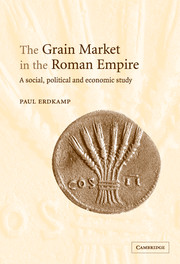Book contents
- Frontmatter
- Contents
- List of maps
- Acknowledgements
- Map 1 Asia Minor
- Map 2 Greece
- Map 3 Italy
- Map 4 The Roman World
- Map 5 Egypt
- Introduction
- 1 Production and productivity in Roman agriculture
- 2 The world of the smallholder
- 3 Farmers and their market relations
- 4 Market integration: connecting supply and demand
- 5 Rome and the corn provinces
- 6 Urban food supply and grain market intervention
- Conclusions
- References
- General index
- Index locorum
4 - Market integration: connecting supply and demand
Published online by Cambridge University Press: 04 November 2009
- Frontmatter
- Contents
- List of maps
- Acknowledgements
- Map 1 Asia Minor
- Map 2 Greece
- Map 3 Italy
- Map 4 The Roman World
- Map 5 Egypt
- Introduction
- 1 Production and productivity in Roman agriculture
- 2 The world of the smallholder
- 3 Farmers and their market relations
- 4 Market integration: connecting supply and demand
- 5 Rome and the corn provinces
- 6 Urban food supply and grain market intervention
- Conclusions
- References
- General index
- Index locorum
Summary
INTRODUCTION
The economics of the grain market are dominated by a few important facts. First, grain is harvested once a year, but consumed throughout the year. This leads to an annual cycle of growth and consumption. Moreover, seed-corn had to be stored until sowing time. Secondly, the vagaries of the weather create heavy fluctuations in production, but the consequences of the weather are local and independent. The differences between separate years and separate regions bring in two further elements: time and space, the first regarding the inter-annual distribution of corn, the latter regarding its inter-regional distribution. Moreover, in the ancient world market supply was not so much determined by total harvest as by the amount of surplus production. Because the ancient yields were low and much of production was in the hands of smallholders, who consumed a large and inelastic part of their production, market supply fluctuated even more heavily than harvests. The degree to which the market succeeds in compensating for harvest shocks (i.e. fluctuations in harvest size) is called market integration. There are two ways of compensating for harvest shocks: first, transporting surpluses to regions experiencing shortage; second, storing surpluses until the next harvest year, which is called carry-over. Regarding carry-over, storage as such is not important, but the degree to which part of the harvest of one agricultural cycle was carried over into the next.
- Type
- Chapter
- Information
- The Grain Market in the Roman EmpireA Social, Political and Economic Study, pp. 143 - 205Publisher: Cambridge University PressPrint publication year: 2005
- 2
- Cited by



